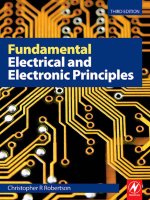Bài giảng Electrical and electronic principles: Chương 2 - ThS. Ngô Quốc Cường
Bạn đang xem bản rút gọn của tài liệu. Xem và tải ngay bản đầy đủ của tài liệu tại đây (705.35 KB, 30 trang )
TRƯỜNG ĐẠI HỌC SƯ PHẠM KỸ THUẬT
TP. HỒ CHÍ MINH
ELECTRICAL AND ELECTRONIC
PRINCIPLES
WEEK 2
Cuong Q. Ngo
Last classes
• Branch; node; loop
• KCL
• KVL
2
CONTENTS (Today)
• Methods of analysis
• Thevenin’s theorem
• Norton theorem
3
Methods of analysis
• Mesh analysis
• Nodal analysis
4
1.1 Mesh analysis
• A mesh is a loop which does not contain any other loops
within it.
• Paths abefa and bcdeb are meshes, but path abcdefa is not
a mesh.
5
1.1 Mesh analysis
6
1.1 Mesh analysis
• Find the branch currents and using mesh analysis
7
1.1 Mesh analysis
8
1.1 Mesh analysis
• Use mesh analysis to find the current in the circuit below
9
1.1 Mesh analysis
• Solution
10
1.1 Mesh analysis
• Mesh Analysis with Current Sources
– Case 1: When a current source exists only in one mesh
• In the above circuit, we set i2 = - 5 A
11
1.1 Mesh analysis
• Mesh Analysis with Current Sources
– Case 2: When a current source exists between two
meshes
12
1.2 Nodal analysis
• Nodal analysis provides a general procedure for analyzing
circuits using node voltages as the circuit variables.
•
13
1.2 Nodal analysis
• Calculate the node voltages (1; 2) in the circuit below
14
1.2 Nodal analysis
• At node 1
• At node 2
15
2.1 Thevenin’s theorem
• Finding Vth and Rth
16
2.1 Thevenin’s theorem
• If the network has dependent source
17
2.1 Thevenin’s theorem
• Find the Thevenin equivalent circuit of the circuit to the left of
terminal a-b
• Then find the current through RL = 6, 16 Ω
18
• Answer
Rth = 4; Vth = 30
19
2.1 Thevenin’s theorem
• Problem 1
• Using Thevenin’s theorem, find the equivalent circuit to the
left of the terminals a-b in the circuit below. Then find I.
20
• Answer
21
2.1 Thevenin’s theorem
• Problem 2*
• Find the Thevenin equivalent of the circuit at the terminals: ab
22
• Answer
23
Norton’s theorem
24
Norton’s theorem
• Finding Norton current
25









